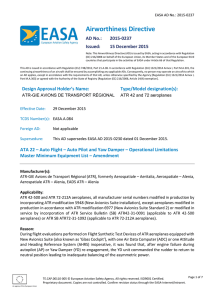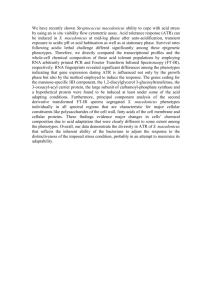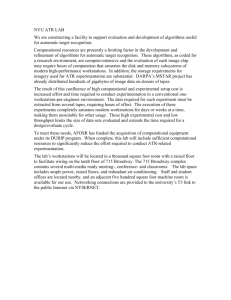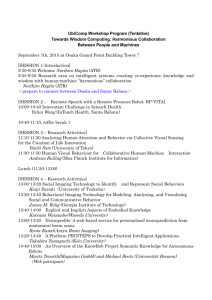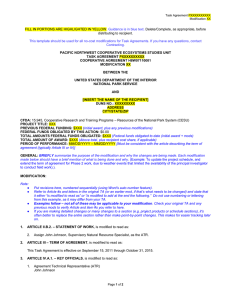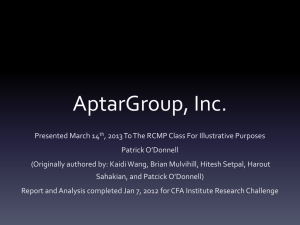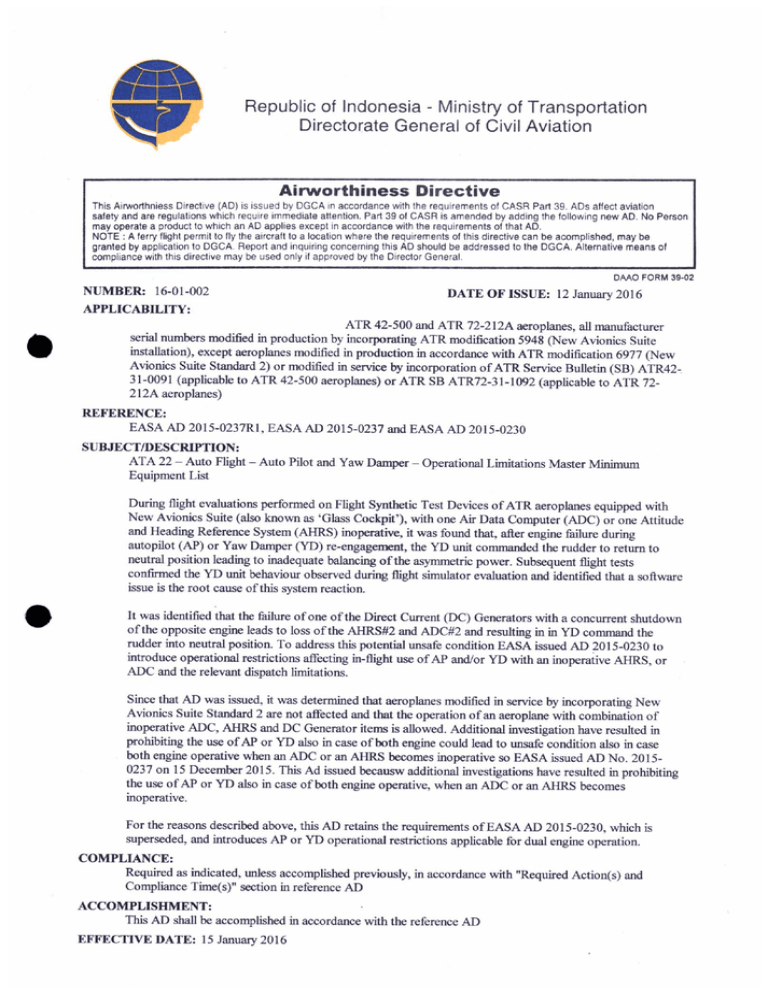
Republic of Indonesia - Ministry of Transportation
Directorate General of Civil Aviation
Ai
rwo
rt
hin
es
s D
ir
ect
iv
e
Thi
s Air
wo
rth
ni
ess
D
ire
ct
ive
{
AD)
i
s i
ss
ued
b
y D
GC
A i
n acc
or
dan
ce
wi
th
1h
e req
ui
rem
en
ts oi
C
AS
R
Pa
r
t
3
9
A
D
s
a
H
e
ct
a
v
ia
t
i
on
saf
et
y a
nd
ar
e reg
ul
ati
on
s w
hi
ch r
a
qu
i
r
e
i
m
m
ed
i
a
te
a
tt
e
n
ti
o
n
. P
a
r
t 3
9
o
f
CA
S
R
i
s
am
e
n
de
d
b
y a
d
di
n
g
t
h
e
f
o
l
lo
w
i
ng
n
e
w A
D
N
o
Pe
r
s
on
may operate a product to which an AD applies except in accordance with the requirements of that AD.
NOT
E : A
t
err
y fli
gh
t p
e
r
mi
t
t
o 1
1
y t
h
e a
i
rc
r
a
tt
t
o a
l
oc
a
t
io
n
wh
e
r
e t
h
e r
e
qu
i
r
e
me
n
t
s o
f
t
h
i
s d
i
re
c
t
iv
e
c
an
b
a a
c
om
p
l
is
h
e
d,
m
ay
b
e
gra
nt
ed by
ap
pl
ica
ti
on to
DG
CA
. f
le
por
t and
i
nqu
ir
ing
c
onc
er
nin
g thi
s AD sh
oul
d b
e
a
d
d
re
s
s
ed
t
o t
h
e D
G
CA
A
l
te
r
n
at
i
w
m
e
a
ns
o
f
com
pl
ian
ce
wi
th
th
is
di
re
cti
ve
ma
y be us
ed on
ly il
ap
pr
ove
d by th
e D
ir
ect
or
Ge
ne
ral
OAAO FOR
M 39-02
NUMBER: 16-01-002 DATE OFISSUE: 12 January 2016
APPLICABILITY:
ATR 42-500 and ATR 72-2
12A aero
planes, all manuf
acturer
rl
u
serial numbers modified in production by incorporating ATR modification 5948 (New Avionics Suite
installation), except aeroplanes modif ̄ed in production in accordance with ATR modification 6977 (New
Avionics Suite Standard 2) or modified in service by incorporation of ATR Service Bulletin (SB) ATR42-
31-0091 (applicable to ATR 42-500 aeroplanes) or ATR SB ATR72-31-I092 (applicable to ATR 72-
212A aeroplanes)
REFERENCE:
EASA AD 2015-0237R1, EASA AD 2015-0237 and EASA AD 2015-0230
SUBJECT/DESCRIPTION:
ATA 22 - Auto Flight - Auto Pilot and Yaw Damper - Operational Limitations Master Minimum
Equipment List
During flight evaluati
ons performed on Flight S
ynthetic Test Devices of ATR aeroplanes equipped w
ith
New Avionics Suite (also known as ;Glass Cockpi
t'), with one Air Data Co
mputer (ADC) or one Attit
ude
and Heading Reference System (AHRS) inoperative, it was found that, after engine fail
ure during
autopilot (AP) or Yaw Damper (YD) re-engagement, the YD unit commanded the rudder to retum to
neutral position leading to inadequate balancing of t
he asymmetric power. Subs
equent flight tests
confir
med the YD unit behaviour
observed during flight s
imulato
r eva
lu
ati
on
an
d ide
nt
ifi
ed
th
at
a so
fiw
ar
e
issue
is the root cause of thi
s system reaction.
r-i
LJ
It was identified that
the failure of one of th
e Direct Curr
en
t (
DC
) G
en
era
to
rs wi
th a con
cu
rre
nt
sh
ut
dow
n
of the opposite engine leads to loss of the AHRS#2 and ADC#2 and resulting in in YD command the
rudder into neutral position. To address this
potential unsafe conditi
on EASA issued AD 2015-02
30 to
introduce operational restrictions affecting in
-flight use of AP and/or YD with an inoperat
ive
A
HRS
, or
ADC and the relevant d
ispatch limitations.
For the reas
ons described above, t
hi
s A
D ret
ai
ns th
e r
eq
uir
em
ent
s of EA
SA AD
20
15
-02
30
. w
hi
ch is
su
pe
rse
de
d, an
d i
nt
rod
uc
es AP
or
Y
D o
pe
rat
io
nal
r
est
ri
cti
on
s a
pp
lic
ab
le fo
r d
ua
l e
ng
ine
o
per
at
ion
.
CO
MPLIANCE:
Required as indicated, unless acco
mp
lis
he
d p
re
vio
us
ly,
in
ac
co
rda
nc
e w
it
h "
Re
qui
re
d A
ct
ion
(s
) a
nd
CompEance Time
(s)" section in reference
AD
AC
COMPLISHMENT:
This AD shall be accomplished in accordance with the reference AD
EF
FECTIVE DATE: 15 January 2016
EASA AD No.: 2015-0230
Airworthiness Directive
AD No.:
2015-0230
Issued:
01 December 2015
Note: This Airworthiness Directive (AD) is issued by EASA, acting in accordance with Regulation
(EC) 216/2008 on behalf of the European Union, its Member States and of the European third
countries that participate in the activities of EASA under Article 66 of that Regulation.
This AD is issued in accordance with Regulation (EU) 748/2012, Part 21.A.3B. In accordance with Regulation (EU) 1321/2014 Annex I, Part M.A.301, the
continuing airworthiness of an aircraft shall be ensured by accomplishing any applicable ADs. Consequently, no person may operate an aircraft to which
an AD applies, except in accordance with the requirements of that AD, unless otherwise specified by the Agency [Regulation (EU) 1321/2014 Annex I,
Part M.A.303] or agreed with the Authority of the State of Registry [Regulation (EC) 216/2008, Article 14(4) exemption].
Type/Model designation(s):
Effective Date:
15 December 2015
TCDS Number(s): EASA.A.084
Not applicable
Supersedure:
None
PE
RS
Foreign AD:
ATR 42 and 72 aeroplanes
ED
ATR-GIE AVIONS DE TRANSPORT RÉGIONAL
ED
Design Approval Holder’s Name:
ATA 22 – Auto Flight – Auto Pilot and Yaw Damper – Operational Limitations
Master Minimum Equipment List – Amendment
Manufacturer(s):
ATR-GIE Avions de Transport Régional (ATR), formerly Aerospatiale – Aeritalia, Aerospatiale – Alenia,
Aerospatiale ATR – Alenia, EADS ATR – Alenia
SU
Applicability:
ATR 42-500 and ATR 72-212A aeroplanes, all manufacturer serial numbers modified in production by
incorporating ATR modification 5948 (New Avionics Suite installation), except aeroplanes modified in
accordance with ATR modification 6977 (New Avionics Suite Standard 2).
Reason:
During flight evaluations performed on Flight Synthetic Test Devices of ATR aeroplanes equipped with
New Avionics Suite (also known as ‘Glass Cockpit’), with one Air Data Computer (ADC) or one Attitude
and Heading Reference System (AHRS) inoperative, it was found that, after engine failure during
autopilot (AP) or Yaw Damper (YD) re-engagement, the YD unit commanded the rudder to return to
neutral position leading to inadequate balancing of the asymmetric power.
Subsequent flight tests confirmed the YD unit behaviour observed during flight simulator evaluation
and identified that a software issue is the root cause of this system reaction.
Page 1 of 7
TE.CAP.00110-005 © European Aviation Safety Agency. All rights reserved. ISO9001 Certified.
Proprietary document. Copies are not controlled. Confirm revision status through the EASA-Internet/Intranet.
An agency of the European Union
EASA AD No.: 2015-0230
Additionally, it was identified that the failure of one of the Direct Current (DC) Generators with a
concurrent shutdown of the opposite engine leads to loss of the AHRS#2 and ADC#2 and resulting in
in YD command the rudder into neutral position.
This condition, if not corrected, could result in loss of control of the aeroplane.
For the reasons described above, this AD introduces operational restrictions affecting in-flight use of
AP and/or YD with an inoperative AHRS, or ADC and the relevant dispatch limitations.
Required Action(s) and Compliance Time(s):
Required as indicated, unless accomplished previously:
From the effective date of this AD, do not use AP nor YD during flight with one engine
inoperative, when one of the following fault messages appears in Amber on the Engine &
Warning Display:
(1.1) ADC, or
(1.2) AHRS.
ED
(1)
ED
This AD is considered an interim action and further AD action may follow.
Amending the Aircraft Flight Manual (AFM) of an aeroplane by inserting a copy of this AD into
the applicable AFM of an aeroplane and, concurrently, informing all flight crews is acceptable
to comply with the requirements of paragraph (1) of this AD for that aeroplane.
(3)
Not later than on the effective date of this AD, amend the applicable ATR MMEL, on the basis
of which the operator’s MEL is established, by incorporating the dispatch restrictions as listed
in Appendix 1 of this AD, inform all flight crews and, thereafter, operate the aeroplane
accordingly.
PE
RS
(2)
SU
Note: For affected ATR operators registered in Europe, amending the operator’s MEL after any
applicable change to the MMEL is required by Commission Regulation (EU) 965/2012.
(4)
(4)
From the effective date of this AD, dispatch of an aeroplane with inoperative equipment, as
identified in Table 1 of this AD is allowed, provided that the MEL of that aeroplane has been
amended to be consistent with the MMEL restrictions as specified in Appendix 1 of this AD.
Table 1 – Inoperative Equipment
Only a single unit is allowed to be inoperative
(A, B or C)
A
1 of 2 ADC
B
1 of 2 AHRS
C
1 of 2 DC Generators
Amending the ATR MMEL of an aeroplane by inserting a copy of this AD or incorporating a later
MMEL revision which includes the same dispatch restrictions as detailed in Appendix 1 of this
Page 2 of 7
TE.CAP.00110-005 © European Aviation Safety Agency. All rights reserved. ISO9001 Certified.
Proprietary document. Copies are not controlled. Confirm revision status through the EASA-Internet/Intranet.
An agency of the European Union
EASA AD No.: 2015-0230
AD and concurrently informing all flight crews is acceptable to comply with the requirements
of paragraph (3) of this AD for that aeroplane.
Ref. Publications:
None
Remarks:
1. If requested and appropriately substantiated, EASA can approve Alternative Methods of
Compliance for this AD.
Based on the required actions and the compliance time, EASA have decided to issue a Final AD
with Request for Comments, postponing the public consultation process until after publication.
3.
Enquiries regarding this AD should be referred to the EASA Safety Information Section,
Certification Directorate. E-mail: ADs@easa.europa.eu.
4.
For any question concerning the technical content of the requirements in this AD, please
contact:
ATR - GIE Avions de Transport Régional,
Continued Airworthiness Service,
Tel.: +33 (0)5 62 21 62 21 - Fax: +33 (0) 5 62 21 67 18;
E-mail: continued.airworthiness@atr-aircraft.com.
SU
PE
RS
ED
ED
2.
Page 3 of 7
TE.CAP.00110-005 © European Aviation Safety Agency. All rights reserved. ISO9001 Certified.
Proprietary document. Copies are not controlled. Confirm revision status through the EASA-Internet/Intranet.
An agency of the European Union
EASA AD No.: 2015-0230
Appendix 1 – MMEL amendment
(1)
DC Generator loss
(1.1)
Dispatch conditions
ATA 24 – ELECTRICAL POWER (Continued)
ATA CHAPTER
1 2 - REPAIR INTERVAL CATEGORY
3 - NUMBER INSTALLED
4 - NUMBER REQUIRED FOR DISPATCH
ITEM
5 - REMARKS OR CONDITIONS
DC
ED
A 2 1 * (o) (m) May be inoperative except for ETOPS, provided:
(a) The Autopilot and Yaw Damper are deactivated, and
(b) TRU is checked operative prior to each departure,
and
(c) Aircraft does not fly extended overwater routes, and
(d) Two engines taxi is performed, and
(e) Aircraft does not line up until 6 minutes elapsed
after operative generator comes on line, and
(f) Operations are limited to two flights
ED
30-1 DC generator channel
(generator + related GCU)
SU
PE
RS
Note: This new dispatch condition only supersedes the related current approved MMEL items
applicable to ATR 42-500 and ATR 72-212A fitted with ATR Modification 5948, except aeroplanes
modified in accordance with ATR modification 6977, the others dispatch conditions remain valid.
Page 4 of 7
TE.CAP.00110-005 © European Aviation Safety Agency. All rights reserved. ISO9001 Certified.
Proprietary document. Copies are not controlled. Confirm revision status through the EASA-Internet/Intranet.
An agency of the European Union
EASA AD No.: 2015-0230
Appendix 1 – MMEL amendment (continued)
(1.2)
Associated procedures
Dispatch Deviation Guide
ATA 24 – ELECTRICAL POWER
30-1 DC generator channel (generator + related GCU)
OPERATIONAL PROCEDURES :
Check of remaining generator feeder integrity:
6 minutes are necessary to establish the temperature difference between the feeders if one line is broken. So
aircraft should not line up until 6 minutes elapsed after operative generator comes on line.
Operational test of TRU (if installed):
Note: During the test, the ACW electrical network must be available (The AC GPU connected or ACW
generators running).
Checking are performed only on Main Electrical Panel (left hand panel):
- Switch OFF the pushbutton DC EXTERNAL POWER (if selected ON)
- Switch OFF the pushbuttons DC GEN 1 & 2 (if selected ON)
ED
ED
PE
RS
On Main Electrical Panel; check that the following caution lights are switched ON:
- BATTERY ARROWS
- Both BUS OFF
- INVERTER 2 FAULT
- Both DC BUS OFF
- SHED LEGEND OF DC SVCE/UTLY BUS
Check that the following systems are supplied:
- VHF 1
- FUEL QTY INDICATOR
- FLAPS POSITION INDICATOR
SU
On Main Electrical Panel; press the TRU push-button; then check that:
- The TRU push-button is switched ON
- The TRU ARROW caution light is switched ON
- The BATTERIES ARROWS caution lights are not illuminated
- The UNDV legend of OVRD/UNDV push-button is not illuminated
On Main Electrical Panel, check that the BATTERY AMMETER shows zero load either if BAT selector switch is
placed in EMER or MAIN position.
Check that the following systems are still supplied:
- VHF 1
- FUEL QTY INDICATOR
- FLAPS POSITION INDICATOR
On Main Electrical Panel, switch off the TRU push-button; then check that:
- The TRU push-button is not illuminated
- The TRU ARROW caution light is not illuminated
- The BATTERY ARROWS caution lights are switched ON
MAINTENANCE PROCEDURES :
- Pull C/B AFCS/YAW SERVO, secure and tag
Page 5 of 7
TE.CAP.00110-005 © European Aviation Safety Agency. All rights reserved. ISO9001 Certified.
Proprietary document. Copies are not controlled. Confirm revision status through the EASA-Internet/Intranet.
An agency of the European Union
EASA AD No.: 2015-0230
Appendix 1 – MMEL amendment (continued)
ADC or AHRS fault
(2.1)
Dispatch conditions
ATA 34 – NAVIGATION
ATA CHAPTER
1
ITEM
Air Data System
11-1 Air Data Computer (ADC)
A 2 1 * (o) (m) One ADC may be inoperative provided:
(a) The Autopilot and Yaw Damper are deactivated, and
(b) The TLU manual mode is operative
(c) The IESI is operative, and
(d) All the IOM DC are operative, and
(e) The operations are limited to two flights, and
(f) For day VMC flight only, and
(g) For ETOPS, the ADC#1 must be operative
ED
-
2 - REPAIR INTERVAL CATEGORY
3 - NUMBER INSTALLED
4 - NUMBER REQUIRED FOR DISPATCH
5 - REMARKS OR CONDITIONS
ED
(2)
Note : When TLU automatic mode is inoperative
Refer to MMEL 27 item 23-2
-
Attitude – Heading
A 2 1 *
(m) One may be inoperative, provided:
(a) The Autopilot and Yaw Damper are deactivated, and
(b) The IESI is operative, and
(c) For day VMC flight only, and
(d) Operations are limited to two flights, and
(e) For ETOPS, AHRS#1 must be operative
PE
RS
20-1 AHRS
SU
This new dispatch condition only supersedes the related current approved MMEL items applicable
to ATR 42-500 and ATR 72-212A fitted with ATR Modification 5948, except aeroplanes modified in
accordance with ATR modification 6977, the others dispatch conditions remain valid.
Page 6 of 7
TE.CAP.00110-005 © European Aviation Safety Agency. All rights reserved. ISO9001 Certified.
Proprietary document. Copies are not controlled. Confirm revision status through the EASA-Internet/Intranet.
An agency of the European Union
EASA AD No.: 2015-0230
Appendix 1 – MMEL amendment (end)
(2.2)
Associated procedures
Dispatch Deviation Guide
ATA 34 – NAVIGATION
11-1 ADC
OPERATIONAL PROCEDURES :
ADC switching must be set to valid ADC
ED
MAINTENANCE PROCEDURES :
ED
TLU manual mode check:
Select HI SPD and check alert is generated after 25 seconds: MC, SC, FLT CTL TLU on FWS and TLU FAULT light
Check rudder travel is limited
Select AUTO and check alert stops after 15 seconds
Check rudder travel is not limited
- Pull C/B AFCS/YAW SERVO, secure and tag
20-1 AHRS
PE
RS
OPERATIONAL PROCEDURES :
None for this chapter
MAINTENANCE PROCEDURES :
SU
- Pull C/B AFCS/YAW SERVO, secure and tag.
Page 7 of 7
TE.CAP.00110-005 © European Aviation Safety Agency. All rights reserved. ISO9001 Certified.
Proprietary document. Copies are not controlled. Confirm revision status through the EASA-Internet/Intranet.
An agency of the European Union
EASA AD No.: 2015-0237R1
Airworthiness Directive
AD No.:
2015-0237R1
Issued:
16 December 2015
Note: This Airworthiness Directive (AD) is issued by EASA, acting in accordance with Regulation
(EC) 216/2008 on behalf of the European Union, its Member States and of the European third
countries that participate in the activities of EASA under Article 66 of that Regulation.
This AD is issued in accordance with Regulation (EU) 748/2012, Part 21.A.3B. In accordance with Regulation (EU) 1321/2014 Annex I, Part M.A.301, the
continuing airworthiness of an aircraft shall be ensured by accomplishing any applicable ADs. Consequently, no person may operate an aircraft to which
an AD applies, except in accordance with the requirements of that AD, unless otherwise specified by the Agency [Regulation (EU) 1321/2014 Annex I,
Part M.A.303] or agreed with the Authority of the State of Registry [Regulation (EC) 216/2008, Article 14(4) exemption].
Design Approval Holder’s Name:
Type/Model designation(s):
ATR-GIE AVIONS DE TRANSPORT RÉGIONAL
ATR 42 and 72 aeroplanes
Effective Date:
29 December 2015 [same as the original issue]
TCDS Number(s): EASA.A.084
Foreign AD:
Not applicable
Revision:
This AD revises EASA AD 2015-0237 dated 15 December 2015, which superseded
EASA AD 2015-0230 dated 01 December 2015.
ATA 22 – Auto Flight – Auto Pilot and Yaw Damper – Operational Limitations
Master Minimum Equipment List – Amendment
Manufacturer(s):
ATR-GIE Avions de Transport Régional (ATR), formerly Aerospatiale – Aeritalia, Aerospatiale – Alenia,
Aerospatiale ATR – Alenia, EADS ATR – Alenia
Applicability:
ATR 42-500 and ATR 72-212A aeroplanes, all manufacturer serial numbers modified in production by
incorporating ATR modification 5948 (New Avionics Suite installation), except aeroplanes modified in
production in accordance with ATR modification 6977 (New Avionics Suite Standard 2) or modified in
service by incorporation of ATR Service Bulletin (SB) ATR42-31-0091 (applicable to ATR 42-500
aeroplanes) or ATR SB ATR72-31-1092 (applicable to ATR 72-212A aeroplanes).
Reason:
During flight evaluations performed on Flight Synthetic Test Devices of ATR aeroplanes equipped with
New Avionics Suite (also known as ‘Glass Cockpit’), with one Air Data Computer (ADC) or one Attitude
and Heading Reference System (AHRS) inoperative, it was found that, after engine failure during
autopilot (AP) or Yaw Damper (YD) re-engagement, the YD unit commanded the rudder to return to
neutral position leading to inadequate balancing of the asymmetric power.
Page 1 of 7
TE.CAP.00110-005 © European Aviation Safety Agency. All rights reserved. ISO9001 Certified.
Proprietary document. Copies are not controlled. Confirm revision status through the EASA-Internet/Intranet.
An agency of the European Union
EASA AD No.: 2015-0237R1
Subsequent flight tests confirmed the YD unit behaviour observed during flight simulator evaluation
and identified that a software issue is the root cause of this system reaction.
Additionally, it was identified that the failure of one of the Direct Current (DC) Generators with a
concurrent shutdown of the opposite engine leads to loss of the AHRS#2 and ADC#2 and resulting in
in YD command the rudder into neutral position.
This condition, if not corrected, could result in loss of control of the aeroplane.
To address this potential unsafe condition EASA issued AD 2015-0230 to introduce operational
restrictions affecting in-flight use of AP and/or YD with an inoperative AHRS, or ADC and the
relevant dispatch limitations.
Since that AD was issued, it was determined that aeroplanes modified in service by incorporating
New Avionics Suite Standard 2 are not affected and that the operation of an aeroplane with
combination of inoperative ADC, AHRS and DC Generator items is allowed. Additional investigation
have resulted in prohibiting the use of AP or YD also in case of both engine operative, when an ADC
or an AHRS becomes inoperative.
For the reasons described above, this AD retains the requirements of EASA AD 2015-0230, which is
superseded, and introduces AP or YD operational restrictions applicable for dual engine operation.
This AD is considered an interim action and further AD action may follow.
This AD is revised to specify the Reason leading to AD issuance.
Required Action(s) and Compliance Time(s):
Required as indicated, unless accomplished previously:
(1)
From the effective date of this AD, do not use AP nor YD during flight, when one of the following
fault messages appears in Amber on the Engine & Warning Display:
(1.1) ADC, or
(1.2) AHRS.
(2)
Amending the Aircraft Flight Manual (AFM) of an aeroplane by inserting a copy of this AD into
the applicable AFM of an aeroplane and, concurrently, informing all flight crews is acceptable
to comply with the requirements of paragraph (1) of this AD for that aeroplane.
(3)
Not later than on 15 December 2015 [the effective date of EASA AD 2015-0230], amend the
applicable ATR Master Minimum Equipment List (MEL), on the basis of which the operator’s
MEL is established, by incorporating the dispatch restrictions as listed in Appendix 1 of this AD,
inform all flight crews and, thereafter, operate the aeroplane accordingly.
Note: For affected ATR operators registered in Europe, amending the operator’s MEL after any
applicable change to the MMEL is required by Commission Regulation (EU) 965/2012.
Page 2 of 7
TE.CAP.00110-005 © European Aviation Safety Agency. All rights reserved. ISO9001 Certified.
Proprietary document. Copies are not controlled. Confirm revision status through the EASA-Internet/Intranet.
An agency of the European Union
EASA AD No.: 2015-0237R1
(4)
From the effective date of this AD, dispatch of an aeroplane with inoperative equipment, as
identified in paragraph (4.1) or (4.2) or (4.3) of this AD is allowed, provided that the MEL of that
aeroplane has been amended to be consistent with the Master MEL restrictions as specified in
Appendix 1 of this AD.
(4.1)
One of 2 ADC’s inoperative,
(4.2)
One of 2 AHRS’s inoperative,
(4.3)
One of 2 DC Generator’s inoperative.
(5)
Amending the ATR Master MEL of an aeroplane by inserting a copy of this AD or incorporating
a later Master MEL revision which includes the same dispatch restrictions as detailed in
Appendix 1 of this AD and concurrently informing all flight crews is acceptable to comply with
the requirements of paragraph (3) of this AD for that aeroplane.
(6)
Modification of an aeroplane, after the effective date of this AD, in accordance with ATR SB
ATR42-31-0091 or ATR SB ATR72-31-1092, as applicable to aeroplane model, is an acceptable
method to comply with the requirements of this AD.
Ref. Publications:
ATR SB ATR42-31-0091, dated 17 December 2014.
ATR SB ATR72-31-1092, dated 07 October 2014.
The use of later approved revisions of these documents is acceptable for compliance with the
requirements of this AD.
Remarks:
1. If requested and appropriately substantiated, EASA can approve Alternative Methods of
Compliance for this AD.
2.
Based on the required actions and the compliance time, EASA have decided to issue a Final AD
with Request for Comments, postponing the public consultation process until after publication.
3.
Enquiries regarding this AD should be referred to the EASA Safety Information Section,
Certification Directorate. E-mail: ADs@easa.europa.eu.
4.
For any question concerning the technical content of the requirements in this AD, please
contact:
ATR - GIE Avions de Transport Régional,
Continued Airworthiness Service,
Tel.: +33 (0)5 62 21 62 21 - Fax: +33 (0) 5 62 21 67 18;
E-mail: continued.airworthiness@atr-aircraft.com.
Page 3 of 7
TE.CAP.00110-005 © European Aviation Safety Agency. All rights reserved. ISO9001 Certified.
Proprietary document. Copies are not controlled. Confirm revision status through the EASA-Internet/Intranet.
An agency of the European Union
EASA AD No.: 2015-0237R1
Appendix 1 – MMEL amendment
(1)
DC Generator loss
(1.1)
Dispatch conditions
ATA 24 – ELECTRICAL POWER (Continued)
ATA CHAPTER
1 2 - REPAIR INTERVAL CATEGORY
3 - NUMBER INSTALLED
4 - NUMBER REQUIRED FOR DISPATCH
ITEM
5 - REMARKS OR CONDITIONS
DC
30-1 DC generator channel
(generator + related GCU)
A 2 1 * (o) (m) May be inoperative except for ETOPS, provided:
(a) The Autopilot and Yaw Damper are deactivated, and
(b) TRU is checked operative prior to each departure,
and
(c) Aircraft does not fly extended overwater routes, and
(d) Two engines taxi is performed, and
(e) Aircraft does not line up until 6 minutes elapsed
after operative generator comes on line, and
(f) Operations are limited to two flights
Note: This new dispatch condition only supersedes the related current approved MMEL items
applicable to ATR 42-500 and ATR 72-212A fitted with ATR Modification 5948, except aeroplanes
modified in accordance with ATR modification 6977, the others dispatch conditions remain valid.
Page 4 of 7
TE.CAP.00110-005 © European Aviation Safety Agency. All rights reserved. ISO9001 Certified.
Proprietary document. Copies are not controlled. Confirm revision status through the EASA-Internet/Intranet.
An agency of the European Union
EASA AD No.: 2015-0237R1
Appendix 1 – MMEL amendment (continued)
(1.2)
Associated procedures
Dispatch Deviation Guide
ATA 24 – ELECTRICAL POWER
30-1 DC generator channel (generator + related GCU)
OPERATIONAL PROCEDURES :
Check of remaining generator feeder integrity:
6 minutes are necessary to establish the temperature difference between the feeders if one line is broken. So
aircraft should not line up until 6 minutes elapsed after operative generator comes on line.
Operational test of TRU (if installed):
Note: During the test, the ACW electrical network must be available (The AC GPU connected or ACW
generators running).
Checking are performed only on Main Electrical Panel (left hand panel):
- Switch OFF the pushbutton DC EXTERNAL POWER (if selected ON)
- Switch OFF the pushbuttons DC GEN 1 & 2 (if selected ON)
On Main Electrical Panel; check that the following caution lights are switched ON:
- BATTERY ARROWS
- Both BUS OFF
- INVERTER 2 FAULT
- Both DC BUS OFF
- SHED LEGEND OF DC SVCE/UTLY BUS
Check that the following systems are supplied:
- VHF 1
- FUEL QTY INDICATOR
- FLAPS POSITION INDICATOR
On Main Electrical Panel; press the TRU push-button; then check that:
- The TRU push-button is switched ON
- The TRU ARROW caution light is switched ON
- The BATTERIES ARROWS caution lights are not illuminated
- The UNDV legend of OVRD/UNDV push-button is not illuminated
On Main Electrical Panel, check that the BATTERY AMMETER shows zero load either if BAT selector switch is
placed in EMER or MAIN position.
Check that the following systems are still supplied:
- VHF 1
- FUEL QTY INDICATOR
- FLAPS POSITION INDICATOR
On Main Electrical Panel, switch off the TRU push-button; then check that:
- The TRU push-button is not illuminated
- The TRU ARROW caution light is not illuminated
- The BATTERY ARROWS caution lights are switched ON
MAINTENANCE PROCEDURES :
- Pull C/B AFCS/YAW SERVO, secure and tag
Page 5 of 7
TE.CAP.00110-005 © European Aviation Safety Agency. All rights reserved. ISO9001 Certified.
Proprietary document. Copies are not controlled. Confirm revision status through the EASA-Internet/Intranet.
An agency of the European Union
EASA AD No.: 2015-0237R1
Appendix 1 – MMEL amendment (continued)
(2)
ADC or AHRS fault
(2.1)
Dispatch conditions
ATA 34 – NAVIGATION
ATA CHAPTER
1
ITEM
-
2 - REPAIR INTERVAL CATEGORY
3 - NUMBER INSTALLED
4 - NUMBER REQUIRED FOR DISPATCH
5 - REMARKS OR CONDITIONS
Air Data System
11-1 Air Data Computer (ADC)
A 2 1 * (o) (m) One ADC may be inoperative provided:
(a) The Autopilot and Yaw Damper are deactivated, and
(b) The TLU manual mode is operative
(c) The IESI is operative, and
(d) All the IOM DC are operative, and
(e) The operations are limited to two flights, and
(f) For day VMC flight only, and
(g) For ETOPS, the ADC#1 must be operative
Note : When TLU automatic mode is inoperative
Refer to MMEL 27 item 23-2
-
Attitude – Heading
20-1 AHRS
A 2 1 *
(m) One may be inoperative, provided:
(a) The Autopilot and Yaw Damper are deactivated, and
(b) The IESI is operative, and
(c) For day VMC flight only, and
(d) Operations are limited to two flights, and
(e) For ETOPS, AHRS#1 must be operative
This new dispatch condition only supersedes the related current approved MMEL items applicable
to ATR 42-500 and ATR 72-212A fitted with ATR Modification 5948, except aeroplanes modified in
accordance with ATR modification 6977, the others dispatch conditions remain valid.
Page 6 of 7
TE.CAP.00110-005 © European Aviation Safety Agency. All rights reserved. ISO9001 Certified.
Proprietary document. Copies are not controlled. Confirm revision status through the EASA-Internet/Intranet.
An agency of the European Union
EASA AD No.: 2015-0237R1
Appendix 1 – MMEL amendment (end)
(2.2)
Associated procedures
Dispatch Deviation Guide
ATA 34 – NAVIGATION
11-1 ADC
OPERATIONAL PROCEDURES :
ADC switching must be set to valid ADC
TLU manual mode check:
Select HI SPD and check alert is generated after 25 seconds: MC, SC, FLT CTL TLU on FWS and TLU FAULT light
Check rudder travel is limited
Select AUTO and check alert stops after 15 seconds
Check rudder travel is not limited
MAINTENANCE PROCEDURES :
- Pull C/B AFCS/YAW SERVO, secure and tag
20-1 AHRS
OPERATIONAL PROCEDURES :
None for this chapter
MAINTENANCE PROCEDURES :
- Pull C/B AFCS/YAW SERVO, secure and tag.
Page 7 of 7
TE.CAP.00110-005 © European Aviation Safety Agency. All rights reserved. ISO9001 Certified.
Proprietary document. Copies are not controlled. Confirm revision status through the EASA-Internet/Intranet.
An agency of the European Union
Republic of Indonesia - Ministry of Transportatio
n
Directorate General of Civil Aviation
Airworthiness Directive
c
g
N
m
s
T
o
r
O
a
a
h
m
a
T
y
f
i
l
p
t
n
E
o
t
e
s
i
e
:
e
p
y
i
A
n
a
d
A
r
a
r
c
y
b
e
f
t
a
d
n
o
w
e
r
e
r
w
p
a
r
a
r
a
i
t
i
p
y
p
e
n
h
h
i
l
l
f
r
r
i
t
c
i
o
e
e
h
a
g
u
d
u
g
s
s
i
i
t
t
h
c
l
D
d
o
p
t
t
a
i
i
n
e
o
t
i
e
r
r
t
r
o
c
c
e
o
i
m
h
w
s
n
t
t
G
D
t
i
w
v
i
v
i
C
t
h
c
i
h
e
e
A
l
o
h
c
(
m
.
t
y
l
n
a
q
e
r
A
a
p
e
R
a
e
h
A
r
i
u
)
D
y
t
r
o
c
r
i
D
m
i
e
i
e
b
d
n
a
f
a
r
a
d
e
m
i
s
n
i
t
p
a
i
u
s
s
u
i
u
q
l
a
o
l
p
a
e
t
b
d
e
e
n
i
r
a
c
o
i
e
t
G
D
y
d
o
c
g
o
i
t
s
e
i
t
n
i
A
C
o
c
n
w
n
n
o
a
n
l
n
n
r
e
r
e
h
x
e
a
P
.
o
c
y
g
n
i
h
t
e
c
3
t
r
a
d
r
i
i
h
t
r
e
p
e
f
o
9
e
c
n
f
D
A
s
i
u
q
t
S
A
C
t
i
w
a
h
s
e
r
i
i
R
t
h
p
l
u
o
n
e
m
n
m
a
s
r
e
h
r
e
b
d
o
s
t
a
d
n
a
u
q
e
v
o
d
a
h
i
l
o
c
b
d
e
e
r
i
e
e
r
s
i
d
r
a
y
e
m
d
e
s
r
i
d
c
n
a
i
d
s
t
n
b
o
t
d
t
c
e
i
w
e
t
g
n
C
l
o
y
a
h
t
e
v
i
h
t
l
e
h
R
S
A
h
t
C
G
D
n
a
c
r
e
h
l
o
r
a
P
e
.
A
e
b
q
e
w
o
3
t
D
t
l
A
o
c
a
r
i
u
g
n
i
D
A
9
i
n
r
e
l
p
m
m
e
w
e
n
f
a
s
e
r
i
t
a
h
s
i
s
t
n
.
D
A
c
e
f
c
e
v
d
e
i
o
o
N
a
t
r
o
t
a
e
m
a
m
,
i
r
t
r
e
P
a
i
v
n
e
G
o
s
n
e
b
y
A
t
a
n
o
s
o
i
t
a
r
e
f
.
D
n
l
OAAO FORM 39-02
NOTE:
r l
L J
Gen
er
al of
Ci
vi
l A
vi
ati
on
Director of Airwor
thiness and Aircraft Op
era
ti
on
r l
L J

